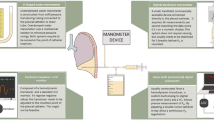Abstract
The measurement of pressure in the pleural space has been performed for more than 120 years. Though interesting from a physiological standpoint in and of itself, it is now often used clinically to minimize the pressure-related complications associated with thoracentesis including the development of symptoms, such as chest discomfort and reexpansion pulmonary edema, as well as to predict the success of pleurodesis in patients with malignant effusions. Unfortunately, the use of pleural manometry at the bedside remains an underutilized technique. This chapter will review the pressure physiology of the pleural space and discuss the clinical application of manometry.
Access this chapter
Tax calculation will be finalised at checkout
Purchases are for personal use only
Similar content being viewed by others
Suggested Reading
West JB. Snorkel breathing in the elephant explains the unique anatomy of its pleura. Respir Physiol. 2001;126(1):1–8.
Feller-Kopman D, Walkey A, Berkowitz D, et al. The relationship of pleural pressure to symptom development during therapeutic thoracentesis. Chest. 2006;129(6):1556–60.
Lan RS, Lo SK, Chuang ML, et al. Elastance of the pleural space: a predictor for the outcome of pleurodesis in patients with malignant pleural effusion. Ann Intern Med. 1997;126(10):768–74.
Agostoni E. Mechanics of the pleural space. Physiol Rev. 1972; 52(1):57–128.
Lai-Fook SJ. Mechanics of the pleural space: fundamental concepts. Lung. 1987;165(5):249–67.
Light RW, Jenkinson SG, Minh VD, et al. Observations on pleural fluid pressures as fluid is withdrawn during thoracentesis. Am Rev Respir Dis. 1980;121(5):799–804.
Huggins JT, Sahn SA, Heidecker J, et al. Characteristics of trapped lung: pleural fluid analysis, manometry, and air-contrast chest CT. Chest. 2007;131(1):206–13.
Heidecker J, Huggins JT, Sahn SA, et al. Pathophysiology of pneumothorax following ultrasound-guided thoracentesis. Chest. 2006;130(4):1173–84.
Doelken P, Huggins JT, Pastis NJ, et al. Pleural manometry: technique and clinical implications. Chest. 2004;126(6):1764–9.
Light RW, Stansbury DW, Brown SE. The relationship between pleural pressures and changes in pulmonary function after therapeutic thoracentesis. Am Rev Respir Dis. 1986;133(4):658–61.
Villena V, Lopez-Encuentra A, Pozo F, et al. Measurement of pleural pressure during therapeutic thoracentesis. Am J Respir Crit Care Med. 2000;162(4 Pt 1):1534–8.
Feller-Kopman D, Berkowitz D, Boiselle P, et al. Large-volume thoracentesis and the risk of reexpansion pulmonary edema. Ann Thorac Surg. 2007;84(5):1656–61.
Estenne M, Yernault JC, De TA. Mechanism of relief of dyspnea after thoracocentesis in patients with large pleural effusions. Am J Med. 1983;74(5):813–9.
Author information
Authors and Affiliations
Corresponding author
Editor information
Editors and Affiliations
Rights and permissions
Copyright information
© 2013 Springer Science+Business Media New York
About this chapter
Cite this chapter
Feller-Kopman, D. (2013). Pleural Manometry. In: Ernst, A., Herth, F. (eds) Principles and Practice of Interventional Pulmonology. Springer, New York, NY. https://doi.org/10.1007/978-1-4614-4292-9_55
Download citation
DOI: https://doi.org/10.1007/978-1-4614-4292-9_55
Published:
Publisher Name: Springer, New York, NY
Print ISBN: 978-1-4614-4291-2
Online ISBN: 978-1-4614-4292-9
eBook Packages: MedicineMedicine (R0)




